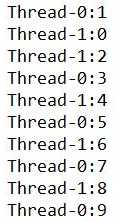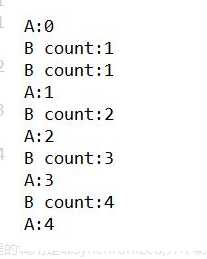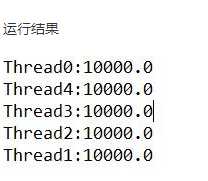标签:als instance 写法 实现 oid sync dem final inf
一 修饰方法
Synchronized修饰一个方法很简单,就是在方法的前面加synchronized,synchronized修饰方法和修饰一个代码块类似,只是作用范围不一样,修饰代码块是大括号括起来的范围,而修饰方法范围是整个函数。
例如:
方法一
public synchronized void method() { // todo }
方法二
public void method() { synchronized(this) { // todo } }
写法一修饰的是一个方法,写法二修饰的是一个代码块,但写法一与写法二是等价的,都是锁定了整个方法时的内容。
synchronized关键字不能继承。
虽然可以使用synchronized来定义方法,但synchronized并不属于方法定义的一部分,因此,synchronized关键字不能被继承。如果在父类中的某个方法使用了synchronized关键字,而在子类中覆盖了这个方法,在子类中的这个方法默认情况下并不是同步的,而必须显式地在子类的这个方法中加上synchronized关键字才可以。当然,还可以在子类方法中调用父类中相应的方法,这样虽然子类中的方法不是同步的,但子类调用了父类的同步方法,因此,子类的方法也就相当于同步了。这两种方式的例子代码如下:
在子类方法中加上synchronized关键字
class Parent { public synchronized void method() { } } class Child extends Parent { public synchronized void method() { } }
在子类方法中调用父类的同步方法
class Parent { public synchronized void method() { } } class Child extends Parent { public void method() { super.method(); } }
二 修饰一个代码块
1)一个线程访问一个对象中的synchronized(this)同步代码块时,其他试图访问该对象的线程将被阻塞
注意下面两个程序的区别
class SyncThread implements Runnable { private static int count; public SyncThread() { count = 0; } public void run() { synchronized(this) { for (int i = 0; i < 5; i++) { try { System.out.println(Thread.currentThread().getName() + ":" + (count++)); Thread.sleep(100); } catch (InterruptedException e) { e.printStackTrace(); } } } } public int getCount() { return count; } } public class Demo00 { public static void main(String args[]){ //test01 //SyncThread s1 = new SyncThread(); //SyncThread s2 = new SyncThread(); //Thread t1 = new Thread(s1); //Thread t2 = new Thread(s2); //test02 SyncThread s = new SyncThread(); Thread t1 = new Thread(s); Thread t2 = new Thread(s); t1.start(); t2.start(); } }
test01的运行结果

test02的运行结果

当两个并发线程(thread1和thread2)访问同一个对象(syncThread)中的synchronized代码块时,在同一时刻只能有一个线程得到执行,另一个线程受阻塞,必须等待当前线程执行完这个代码块以后才能执行该代码块。Thread1和thread2是互斥的,因为在执行synchronized代码块时会锁定当前的对象,只有执行完该代码块才能释放该对象锁,下一个线程才能执行并锁定该对象
为什么上面的例子中thread1和thread2同时在执行。这是因为synchronized只锁定对象,每个对象只有一个锁(lock)与之相关联。
class Counter implements Runnable{ private int count; public Counter() { count = 0; } public void countAdd() { synchronized(this) { for (int i = 0; i < 5; i ++) { try { System.out.println(Thread.currentThread().getName() + ":" + (count++)); Thread.sleep(100); } catch (InterruptedException e) { e.printStackTrace(); } } } } //非synchronized代码块,未对count进行读写操作,所以可以不用synchronized public void printCount() { for (int i = 0; i < 5; i ++) { try { System.out.println(Thread.currentThread().getName() + " count:" + count); Thread.sleep(100); } catch (InterruptedException e) { e.printStackTrace(); } } } public void run() { String threadName = Thread.currentThread().getName(); if (threadName.equals("A")) { countAdd(); } else if (threadName.equals("B")) { printCount(); } } } public class Demo00{ public static void main(String args[]){ Counter counter = new Counter(); Thread thread1 = new Thread(counter, "A"); Thread thread2 = new Thread(counter, "B"); thread1.start(); thread2.start(); } }

可以看见B线程的调用是非synchronized,并不影响A线程对synchronized部分的调用。从上面的结果中可以看出一个线程访问一个对象的synchronized代码块时,别的线程可以访问该对象的非synchronized代码块而不受阻塞。
3)指定要给某个对象加锁
/** * 银行账户类 */ class Account { String name; float amount; public Account(String name, float amount) { this.name = name; this.amount = amount; } //存钱 public void deposit(float amt) { amount += amt; try { Thread.sleep(100); } catch (InterruptedException e) { e.printStackTrace(); } } //取钱 public void withdraw(float amt) { amount -= amt; try { Thread.sleep(100); } catch (InterruptedException e) { e.printStackTrace(); } } public float getBalance() { return amount; } } /** * 账户操作类 */ class AccountOperator implements Runnable{ private Account account; public AccountOperator(Account account) { this.account = account; } public void run() { synchronized (account) { account.deposit(500); account.withdraw(500); System.out.println(Thread.currentThread().getName() + ":" + account.getBalance()); } } } public class Demo00{ //public static final Object signal = new Object(); // 线程间通信变量 //将account改为Demo00.signal也能实现线程同步 public static void main(String args[]){ Account account = new Account("zhang san", 10000.0f); AccountOperator accountOperator = new AccountOperator(account); final int THREAD_NUM = 5; Thread threads[] = new Thread[THREAD_NUM]; for (int i = 0; i < THREAD_NUM; i ++) { threads[i] = new Thread(accountOperator, "Thread" + i); threads[i].start(); } } }

在AccountOperator 类中的run方法里,我们用synchronized 给account对象加了锁。这时,当一个线程访问account对象时,其他试图访问account对象的线程将会阻塞,直到该线程访问account对象结束。也就是说谁拿到那个锁谁就可以运行它所控制的那段代码。
当有一个明确的对象作为锁时,就可以用类似下面这样的方式写程序。
public void method3(SomeObject obj) { //obj 锁定的对象 synchronized(obj) { // todo } }
当没有明确的对象作为锁,只是想让一段代码同步时,可以创建一个特殊的对象来充当锁:
class Test implements Runnable { private byte[] lock = new byte[0]; // 特殊的instance变量 public void method() { synchronized(lock) { // todo 同步代码块 } } public void run() { } }
本例中去掉注释中的signal可以看到同样的运行结果
三 修饰一个静态的方法
Synchronized也可修饰一个静态方法,用法如下:
public synchronized static void method() { // todo }
静态方法是属于类的而不属于对象的。同样的,synchronized修饰的静态方法锁定的是这个类的所有对象。
/** * 同步线程 */ class SyncThread implements Runnable { private static int count; public SyncThread() { count = 0; } public synchronized static void method() { for (int i = 0; i < 5; i ++) { try { System.out.println(Thread.currentThread().getName() + ":" + (count++)); Thread.sleep(100); } catch (InterruptedException e) { e.printStackTrace(); } } } public synchronized void run() { method(); } } public class Demo00{ public static void main(String args[]){ SyncThread syncThread1 = new SyncThread(); SyncThread syncThread2 = new SyncThread(); Thread thread1 = new Thread(syncThread1, "SyncThread1"); Thread thread2 = new Thread(syncThread2, "SyncThread2"); thread1.start(); thread2.start(); } }

syncThread1和syncThread2是SyncThread的两个对象,但在thread1和thread2并发执行时却保持了线程同步。这是因为run中调用了静态方法method,而静态方法是属于类的,所以syncThread1和syncThread2相当于用了同一把锁。
四 修饰一个类
Synchronized还可作用于一个类,用法如下:
class ClassName { public void method() { synchronized(ClassName.class) { // todo } } }
/** * 同步线程 */ class SyncThread implements Runnable { private static int count; public SyncThread() { count = 0; } public static void method() { synchronized(SyncThread.class) { for (int i = 0; i < 5; i ++) { try { System.out.println(Thread.currentThread().getName() + ":" + (count++)); Thread.sleep(100); } catch (InterruptedException e) { e.printStackTrace(); } } } } public synchronized void run() { method(); } }
本例的的给class加锁和上例的给静态方法加锁是一样的,所有对象公用一把锁
总结
A. 无论synchronized关键字加在方法上还是对象上,如果它作用的对象是非静态的,则它取得的锁是对象;如果synchronized作用的对象是一个静态方法或一个类,则它取得的锁是对类,该类所有的对象同一把锁。
B. 每个对象只有一个锁(lock)与之相关联,谁拿到这个锁谁就可以运行它所控制的那段代码。
C. 实现同步是要很大的系统开销作为代价的,甚至可能造成死锁,所以尽量避免无谓的同步控制。
标签:als instance 写法 实现 oid sync dem final inf
原文地址:https://www.cnblogs.com/lukelook/p/9946065.html